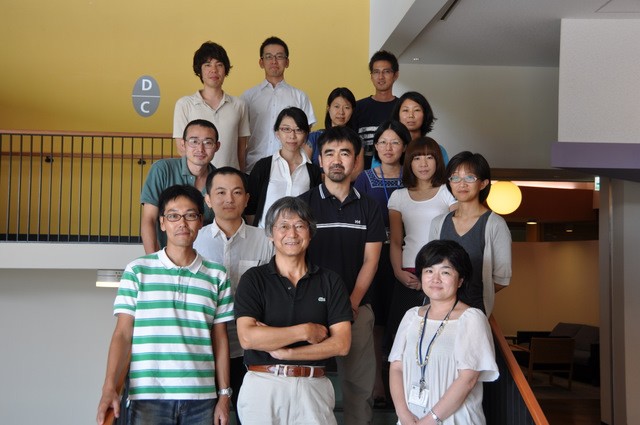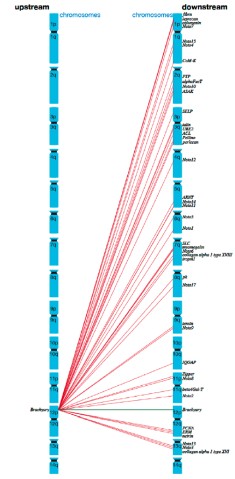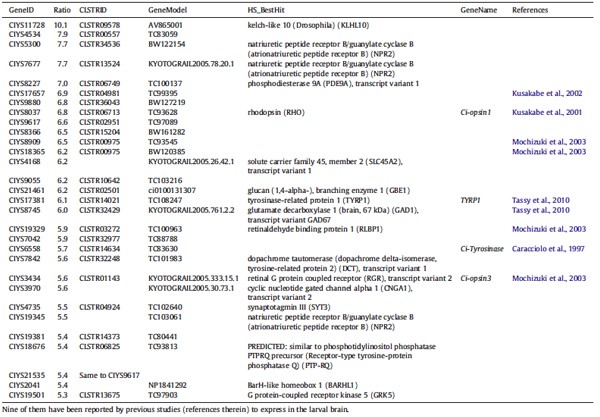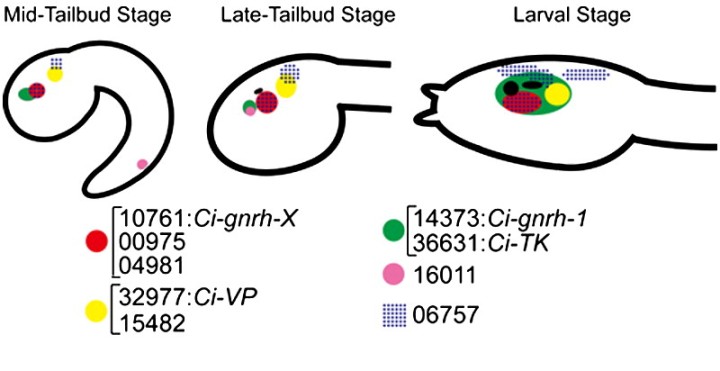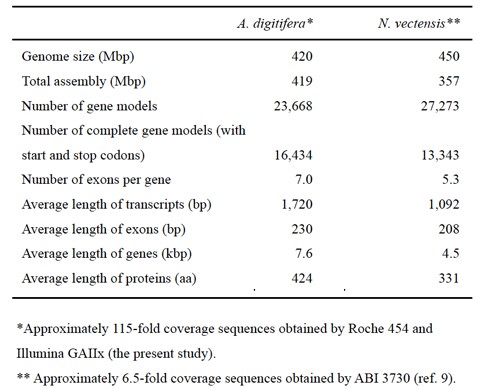Marine Genomics Unit
Principal Investigator: Nori Satoh
Research Theme: Evolutionary, developmental, and environmental genomics of marine invertebrates
Abstract
The genome contains all the genetic information of a given organism. Decoding the genome therefore provides the molecular basis for understanding every biological phenomenon. Since the turn of the 21st century, genomes of various metazoans have been sequenced, and consequently studies progressed efficiently in the fields of evolutionary biology, developmental biology, and environmental biology. The objective of the Marine Genomic Unit is to decode the genomes of target marine invertebrates so as to comprehensively elucidate the molecular mechanisms underlying the (a) evolution, (b) development, and (c) environmental responses of marine animals. The major achievements of the Unit in fiscal year 2010 were as follows.
(a) Evolutionary genomics: We are interested in the origin and evolution of chordates. The notochord is the most prominent feature of chordates, and these organisms were named after this organ. Previously we revealed that a T-box transcription factor, Brachyury (Bra), plays a pivotal role in the formation of the notochord in Ciona embryos and that Ci-Bra regulates more than 400 downstream genes that are involved in the formation of the notochord. This year we focused on the expression regulation of these downstream genes. We showed that the minimal enchancer for each of these eight genes was narrowed to a region approximately 0.5-1.0-kb long, most of which contained Ci-Bra biding sites.
(b) Developmental genomics: Despite containing only approximately 330 cells, the central nervous system (CNS) of Ciona intestinalis larvae has an architecture that is similar to the vertebrate CNS. This year, using transgenic embryos carrying Ci-β- tubulin(promoter)::Kaede, we identified and characterized 565 genes that were preferentially expressed in the larval brain.
(c) Environmental genomics: The coral reefs of the Okinawa islands are amongst the most biologically diverse ecosystems in the world. The key organisms in their establishment, the scleractinian corals, increasingly face a range of human-caused challenges including ocean acidification and seawater temperature rises. In 2010, most of my Unit members have contributed to decoding the genome of the coral Acropora digitifera, an organism that suffered one of the highest mortality rates following the anomalous seawater warming that occurred in the summer of 1998. With the aid of next-generation sequencing technologies, we have almost decoded the coral’s entire 420-Mbp-long genome.
1. Staff
- Group Reader
- Dr. Takeshi Kawashima
- Dr. Eiichi Shoguchi
- Researcher
- Dr. Mayuko Hamada
- Dr. Tetsuro Ikuta (from April 2010)
- Dr. Ryo Koyanagi (from July 2010)
- Dr. Ken Maeda
- Dr. Keisuke Nakashima (from April 2010)
- Dr. Atsuko Sato
- Dr. Chuya Shinzato
- Dr. Takeshi Takeuchi (from June 2010)
- Technical Staff
- Ms. Mayuki Fujiwara
- Ms. Kanako Hisata
- Dr. Makiko Tanaka
- Student
- Mr. Takeshi Noda (from April 2010)
- Mr. Naoki Shimozono
- Research Administrator
- Ms. Shoko Yamakawa
2. Collaborations
- Theme: Decoding of the coral genome
- Type of collaboration: Collaboration
- Researchers:
- Dr. David Miller, James Cook University, Australia
- Theme: Chip-sequence analysis of Ci-Bra target genes
- Type of collaboration: Collaboration
- Researchers:
- Dr. Hiroki Takahashi, National Institute for Basic Biology, Japan
- Theme: Analysis of Ciona genes with transgenic lines
- Type of collaboration: Collaboration
- Researchers:
- Dr. Yasunori Sasakura, Shimoda Marine Research Center, University of Tsukuba, Japan
- Theme: Analysis of the evolution of chordate genomes
- Type of collaboration: Collaboration
- Researchers:
- Dr. Asao Fujiyama, National Institute of Genetics, Japan
3. Activities and Findings
3.1 Evolutionary genomics
We are interested in the origin and evolution of chordates. The notochord is the most prominent feature of chordates, and these organisms were named after this organ. Previously we revealed that a T-box transcription factor, Brachyury (Bra), plays a pivotal role in the formation of the notochord in Ciona embryos and that Ci-Bra regulates more than 400 downstream genes that are involved in the formation of the notochord and characterized the expression profiles of 45 of these in differentiating notochord cells. This year we focused on the expression regulation of these downstream genes. This year we looked for cis-regulatory sequences in minimal enhancers of 20 Ci-Bra downstream genes by electroporating region within approximately 3 kb upstream of each gene fused with lacZ. Eight of the 20 reporters were expressed in notochord cells. The minimal enchancer for each of these eight genes was narrowed to a region approximately 0.5-1.0-kb long. We also explored the genome-wide and coordinate regulation of 43 Ci-Bra-downstream genes. When we determined their chromosomal localization, it became evident that they are not clustered in a given region of the genome, but rather distributed evenly over 13 of the 14 pairs of chromosomes, suggesting that gene clustering does not contribute to coordinate control of the Ci-Bra downstream gene expression (Figure 1).
Figure 1. The genome-wide relationship (red lines) between Ci-Bra (left column) and its downstream genes (right column), indicated by chromosomal position. The green horizontal line signifies the autoregulatory capacity of Ci-Bra. Chromosomes are represented as light blue boxes with a black centromere.
Our results might provide insights into the molecular mechanisms underlying notochord formation in chordates.
3.2 Developmental genomics
Despite containing only approximately 330 cells, the central nervous system (CNS) of Ciona intestinalis larvae has an architecture that is similar to the vertebrate CNS. Although only vertebrates have a distinct hypothalamus—the source of numerous neurohormone peptides that play pivotal roles in the development, function, and maintenance of various neuronal and endocrine systems, it is suggested that the Ciona brain contains a region that corresponds to the vertebrate hypothalamus. To identify genes expressed in the brain, we isolated brain vesicles using transgenic embryos carrying Ci-β-tubulin(promoter)::Kaede,which resulted in robust Kaede expression in the larval CNS. The associated transcriptome was investigated using microarray analysis. We identified 565 genes that were preferentially expressed in the larval brain (Table 1).
Table 1. The top 30 genes with highest expression ratios in the brain of Ciona intestinalis larva.
Among these genes, 11 encoded neurohormone peptides including such hypothalamic peptides as gonadotropin-releasing hormone and oxytocin/vasopressin. Six of the identified peptide genes had not been previously described. We also found that genes encoding receptors for some of the peptides were expressed in the brain. Interestingly, whole-mount in situ hybridization showed that most of the peptide genes were expressed in the ventral brain (Figure 2).
Figure 2. Summary diagram of the expression pattern of peptide genes. The expression profiles of CLSTR10761 (red), 00975 (red), 04981 (red), 32977 (yellow), 15482 (yellow), 14373 (green), 36631 (green), 16011 (magenta), and 06757 (blue dots) at the mid-tailbud stage (left), late-tailbud stage (center), and larval stage (right) are shown. The numbers indicate CLSTR_ID. In case expression signals of the genes were observed at not all the stage, the parentheses indicate the stages at which expression was observed.
This catalog of the genes expressed in the larval brain should help elucidate the evolution, development, and functioning of the chordate brain.
3.3 Environmental genomics
Coral reefs are amongst the most biologically diverse ecosystems on the planet, estimated to harbour around one-third of all described marine species, and their productivity supports around one-quarter of marine fisheries. Reef-building corals (Scleractinia) are anthozoan cnidarians, and have been the major architects of coral reefs since the mid-Triassic. Their spectacular ecological success is attributed to their forming obligate endosymbioses with dinoflagellates of the genus Symbiodinium. Much of the detail of the interaction between coral host and dinoflagellate symbiont is unclear, but this association enables the massive rates of calcification that distinguish reef-building corals from other anthozoans such as sea anemones and zoanthids. Photosynthesis by the symbionts enables the coral holobiont to become essentially phototrophic, but restricts the association to the warm shallow waters of the tropics. Moreover, corals operate near their upper thermal tolerance, and the symbiosis collapses under elevated seawater temperatures, leading to mass coral bleaching (expulsion of symbionts) and mortality. Such bleaching events have become increasingly common and will continue to do so. Furthermore, they are exacerbated by high levels of solar irradiation. Declines in coral abundance lead to wholesale loss of reef habitats and this is one of the most pressing environmental problems of our time. Our ability to address coral decline is limited by a lack of basic molecular data on corals and their symbionts, and our poor understanding of many aspects of the interactions between the two partners. Therefore, this year, my Unit has spent most of its research time decoding the coral genome. We selected Acropora digitifera as a target for genome sequencing because this is a dominant species in Okinawan reefs, and of all corals. A. digitifera suffered amongst the highest mortality rates as a result of the exceptional seawater warming that occurred in the summer of 1998.
OIST has next-generation sequencing machines, namely the Roche 454 GS-FLX and Illumina Genome Analyzer IIx. With the aid of next-generation sequencing technologies, we decoded the approximately 420-Mbp genome of Acropora digitifera. The genome was sequenced to approximately 151-fold coverage, enabling the generation of an assembly comprising a total of 419 Mbp (contig N50=10.7 kbp and scaffold N50=191.5kbp). The genome is approximately 39% GC, and contains 23,668 predicted protein-coding loci. Transposable elements occupy approximately 12.9% of the genome. The coral gene set is comparable in size and composition with those of Nematostella vectensis and Hydra magnipapillata (Table 2).
Table 2. Comparison of gene model between the coral Acropora digitifera and the sea anemone Nematostella vectensis.
Approximately 93% of the A. digitifera genes have matches in other metazoans, and of these, 11% have clear homology only among expressed sequence tag (EST) data from corals, suggesting the presence of a considerable number of coral-specific genes. We are currently attempting to identify the genome genes involved in the establishment of symbiosis, those associated with response to environmental changes, and those responsible for mineralization.
4. Publications
4.1 Journals
Hellsten, U., Harland, R. M., Gilchrist, M. J., Hendrix, D., Jurka, J., Kapitonov, V., Ovcharenko, I., Putnam, N. H., Shu, S., Taher, L., Blitz, I. L., Blumberg, B., Dichmann, D. S., Dubchak, I., Amaya, E., Detter, J. C., Fletcher, R., Gerhard, D. S., Goodstein, D., Graves, T., Grigoriev, I. V., Grimwood, J., Kawashima, T., Lindquist, E., Lucas, S. M., Mead, P. E., Mitros, T., Ogino, H., Ohta, Y., Poliakov, A. V., Pollet, N., Robert, J., Salamov, A., Sater, A. K., Schmutz, J., Terry, A., Vize, P. D., Warren, W. C., Wells, D., Wills, A., Wilson, R. K., Zimmerman, L. B., Zorn, A. M., Grainger, R., Grammer, T., Khokha, M. K., Richardson, P. M., and Rokhsar, D. S. 2010. The genome of the Western clawed frog Xenopus tropicalis. Science 328 (5978):633-636.
Tassy, O., Dauga, D., Daian, F., Sobral, D., Robin, F., Khoueiry, P., Salgado, D., Fox, V., Caillol, D., Schiappa, R., Laporte, B., Rios, A., Luxardi, G., Kusakabe, T., Joly, J. S., Darras, S., Christiaen, L., Contensin, M., Auger, H., Lamy, C., Hudson, C., Rothbacher, U., Gilchrist, M. J., Makabe, K. W., Hotta, K., Fujiwara, S., Satoh, N., Satou, Y., and Lemaire, P. 2010. The ANISEED database: digital representation, formalization, and elucidation of a chordate developmental program. Genome Res 20 (10):1459-1468.
Kubo, A., Suzuki, N., Yuan, X., Nakai, K., Satoh, N., Imai, K. S., and Satou, Y. 2010. Genomic cis-regulatory networks in the early Ciona intestinalis embryo. Development 137 (10):1613-1623.
Ikuta, T., Satoh, N., and Saiga, H. 2010. Limited functions of Hox genes in the larval development of the ascidian Ciona intestinalis. Development 137 (9):1505-1513.
Maeda, K. and Tachibara, K. 2010. Diel and Seasonal Occurrence Patterns of Drifting Fish Larvae in the Teima Stream, Okinawa Island. Pacific Science 64 (2):161-176.
Hozumi, A., Kawai, N., Yoshida, R., Ogura, Y., Ohta, N., Satake, H., Satoh, N., and Sasakura, Y. 2010. Efficient transposition of a single Minos transposon copy in the genome of the ascidian Ciona intestinalis with a transgenic line expressing transposase in eggs. Dev Dyn 239 (4):1076-1088.
Sasakura, Y., Suzuki, M. M., Hozumi, A., Inaba, K., and Satoh, N. 2010. Maternal factor-mediated epigenetic gene silencing in the ascidian Ciona intestinalis. Mol Genet Genomics 283 (1):99-110.
Fujikawa, T., Munakata, T., Kondo, S., Satoh, N., and Wada, S. 2010. Stress response in the ascidian Ciona intestinalis: transcriptional profiling of genes for the heat shock protein 70 chaperone system under heat stress and endoplasmic reticulum stress. Cell Stress Chaperones 15 (2):193-204.
Minamoto, T., Hanai, S., Kadota, K., Oishi, K., Matsumae, H., Fujie, M., Azumi, K., Satoh, N., Satake, M., and Ishida, N. 2010. Circadian clock in Ciona intestinalis revealed by microarray analysis and oxygen consumption. J Biochem 147 (2):175-184.
Ohta, N., Horie, T., Satoh, N., and Sasakura, Y. 2010. Transposon-mediated enhancer detection reveals the location, morphology and development of the cupular organs, which are putative hydrodynamic sensors, in the ascidian Ciona intestinalis. Zoolog Sci 27 (11):842-850.
Shimozono, N., Ohta, N., Satoh, N., and Hamada, M. 2010. Differential regional expression of genes in the developing brain of Ciona intestinalis embryos. Zoolog Sci 27 (2):103-109.
Takahashi, H., Hotta, K., Takagi, C., Ueno, N., Satoh, N., and Shoguchi, E. 2010. Regulation of notochord-specific expression of Ci-Bra downstream genes in Ciona intestinalis embryos. Zoolog Sci 27 (2):110-118.
Yeats, B., Matsumoto, J., Mortimer, S. I., Shoguchi, E., Satoh, N., and Hastings, K. E. 2010. SL RNA genes of the ascidian tunicates Ciona intestinalis and Ciona savignyi. Zoolog Sci 27 (2):171-180.
Koyanagi, R., Zhu, Z., and Asakura, T. 2010. Regenerated Bombyx mori silk fiber with enhanced biodegradability. Journal of Insect Biotechnology and Sericology 79 (1):27-30.
Yamada, S., Ueno, N., Satoh, N., and Takahashi, H. 2011. Ciona intestinalis Noto4 contains a phosphotyrosine interaction domain and is involved in the midline intercalation of notochord cells. Int J Dev Biol 55: 11-18.
Hamada, M., Shimozono, N., Ohta, N., Satou, Y., Horie, T., Kawada, T., Satake, H., Sasakura, Y., and Satoh, N. 2011. Expression of neuropeptide- and hormone-encoding genes in the Ciona intestinalis larval brain. Dev Biol 352: 202-214.
Ogura, Y., Sakaue-Sawano, A., Nakagawa, M., Satoh, N., Miyawaki, A., and Sasakura, Y. 2011. Coordination of mitosis and morphogenesis: role of a prolonged G2 phase during chordate neurulation. Development 138: 577-587.
4.2 Books and other one-time publications
Nothing to report
4.3 Oral and Poster Presentations
Hamada, M., Shoguchi, E., Tanaka, M., Shinzato, C., and Satoh, N. 2010. Identification of genes involved in apoptosis, autophagy and innate immunity in Acropora digitifera. In The 81st Annual Meeting of the Zoological Society of Japan. Tokyo, Japan.
Iitsuka, T., Mita, K., Hamada, M., Satoh, N., and Sasakura, Y. 2010. Target knockdown of maternal transcripts in the ascidian Ciona intestinalis. In The 81st Annual Meeting of the Zoological Society of Japan. Tokyo, Japan.
Kawashima, T. 2010. Comparative Genomics for the Evolution in Metazoan Bodyplan. In Society of Evolutionary Studies,Japan 12th Annual Meeting. Tokyo, Japan.
Kawashima, T. 2010. Study for Symbiosis and Evo-Devo. In The 81st Annual Meeting of the Zoological Society of Japan, The second meeting of the Rising Generation of Evo-Devo Biologists. Tokyo, Japan.
Kawashima, T. 2011. Screening of haplotype SNPs in the diploid genome of Acropora digitifera In ARC CoE Boden Conference - Genome Biology of Corals and their Relatives. Townsville, Australia.
Kawashima, T. and Koyanagi, R. 2011. Draft study for population genetics of a coral genome. In 46th Meeting of SIG-MBI (Special Interest Group on Molecular Biology Informatics, Japanese Society for Artificial Intelligence). Ishikawa, Japan.
Kondo, M., Maeda, K., Yamasaki, N., and Tachihara, K. 2010. Swimming ability and behavior of gobioid larvae. In The 43rd Annual Meeting of The Ichthyological Society of Japan. Mie, Japan.
Maeda, K., Yamasaki, N., and Tachihara, K. 2010. Morphology and occurrence of larvae of five amblyopine species from Okinawa Island. In Goby Researcher’s Meeting. Okinawa, Japan.
Maeda, K., Yamasaki, N., and Tachihara, K. 2010. An undescribed species of the genus Stiphodon from the Ryukyu Archipelago. In The 43rd Annual Meeting of The Ichthyological Society of Japan. Mie, Japan.
Nakashima, K. 2011. Cellulose biosynthesis in animals. In OIST Symposium on Extraordinary Abilities of Animals. Okinawa, Japan.
Noda, T. 2010. Ciona intestinalis p53/p73-a regulates ZicL expression and promotes notochord differentiation. In The 81st Annual Meeting of the Zoological Society of Japan. Tokyo, Japan.
Saito, M., Maeda, K., Kondo, M., and Tachihara, K. 2010. Spawning migration of a freshwater goby, Tridentiger kuroiwae. In Goby Researcher’s Meeting. Okinawa, Japan.
Satoh, N. 2010. The origin and evolution of chordates. In Annual Meeting of Evolutionary Biology, Japan. Tokyo, Japan.
Satoh, N. 2011. Marine genomics of OIST: development, evolution and environmental biology. In ARC CoE Boden Conference - Genome Biology of Corals and their Relatives. Townsville, Australia.
Satoh, N. and Edwin, G. 2010. Beyond the Edwin Conklin's idea. In Annual Meeting of Society of Developmental Biologists. Albuquerque, USA.
Shinzato, C. 2011. Genome sequencing of the coral Acropora digitifera. In ARC CoE Boden Conference - Genome Biology of Corals and their Relatives. Townsville, Australia.
Shinzato, C. and Satoh, N. 2011. Application of genome biological methods for coral biomineralization studies. In Meeting of Biomineralization -from DNA to global environment. Atmosphere and Ocean Research Institute, University of Tokyo, Japan.
Shinzato, C., Shoguchi, E., Kawashima, T., Hamada, M., Hisata, K., Tanaka, M., Fujiwara, M., Fujie, M., and Satoh, N. 2010. The genome sequence of a reef-building coral, Acropora digitifera. In The 81st Annual Meeting of the Zoological Society of Japan. Tokyo, Japan.
Shoguchi, E. 2011. Toward decoding cultured Symbiodinium genome. In ARC CoE Boden Conference - Genome Biology of Corals and their Relatives. Townsville, Australia.
Shoguchi, E., Tanaka, M., Shinzato, C., and Satoh, N. 2010. Candidate genes for biosynthesis of UV absorbing molecules in Acropora digitifera. In The 81st Annual Meeting of the Zoological Society of Japan. Tokyo, Japan.
Yamasaki, N., Maeda, K., and Kondo, M. 2010. Gobioid fish inhabiting in inland waters and coasts influenced by inland water in Miyako Island. In Goby Researcher’s Meeting. Okinawa, Japan.
Hamada, M., Shimozono, N., Ohta, N., Fujie, M., Satou, Y., Horie, T., Kawada, T., Satake, H., Sasakura, Y., and Satoh, N. 2010. Transcriptome Analysis of Ciona intestinalis to Identify Genes Preferentially Expressed in the Larval Brain. In The 43th Annual Meeting for the Japanese Society of Developmental Biologists. Kyoto, Japan.
Ikuta, T., Satoh, N., and Saiga, H. 2010. Limited functions of Hox genes in the larval development of the ascidian, Ciona intestinalis. In The 43th Annual Meeting for the Japanese Society of Developmental Biologists. Kyoto, Japan.
Kawai, N., Ogura, Y., Yoshida, R., Hamada, M., Ikuta, T., Satoh, N., Saiga, H., and Sasakura, Y. 2010. Hox10 regulates migration of endodermal strand cells to form the intestine in the ascidian Ciona intestinalis. In The 33rd Annual Meeting of the Molecular Biology Society of Japan. Kobe, Japan.
Kawashima, T. 2011. Haplotype SNPs in coral genome: examples from GPCR family genes. In 14th Meeting of Open Bio Japan. Nomi, Ishikawa, Japan.
Kondo, M., Tsurugaya, T., Sawafuji, R., Sumiyoshi, N., Omori, A., Ikuta, T., Ota, T., Ikeo, K., Saiga, H., and Akasaka, K. 2011. Use of a crinoid, Oxycomanthus japonicus in development, genomic, and regeneration studies. In Joint Meeting of the German and Japanese Societies of Developmental Biologists. Dresden, German.
Kondo, M., Tsurugaya, T., Sumiyoshi, N., Ikuta, T., Ota, T., Ikeo, K., Saiga, H., and Akasaka, K. 2010. Genomic analysis of the Hox cluster of an echinoderm, Oxycomanthus japonicus. In The 12th Annual Meeting for the Society of Evolutionary Studies. Tokyo, Japan.
Kondo, M., Tsurugaya, T., Sumiyoshi, N., Ikuta, T., Ota, T., Ikeo, K., Saiga, H., and Akasaka, K. 2010. Genomic analysis of the Hox cluster of an echinoderm, Oxycomanthus japonicus. In The 81th Annual Meeting of the Zoological Society of Japan. Tokyo, Japan.
Kondo, M., Tsurugaya, T., Sumiyoshi, N., Ikuta, T., Ota, T., Ikeo, K., Saiga, H., and Akasaka, K. 2010. Genomic analysis of the Hox cluster of an echinoderm, Oxycomanthus japonicus. In The 33rd Annual Meeting of the Molecular Biology Society of Japan. Kobe, Japan.
Koyanagi, R., Fujie, M., Usami, T., and Ikuta, T. 2011. De novo genome assembly using next-generation sequencers: optimization of data amount. In 14th Meeting of Open Bio Japan. Nomi, Ishikawa, Japan.
Shinzato, C., Iguchi, A., Satoh, N., and Hamada, M. 2010. Development of a coral Acropora digitifera cDNA microarray. In The Japanese Coral Reef Society 13th Annual Conference. Tsukuba, Japan.
5. Intellectual Property Rights and Other Specific Achievements
Nothing to report
6. Meetings and Events
6.1 OIST Marine Genomics Seminar
- Title: Ascidian Hox genes.
- Date: Apr 21, 2010
- Venue: OIST Lab1, Okinawa, Japan
- Speaker: Dr. Tetsuro Ikuta, Marine Genomics Unit, OIST, JAPAN
6.2 OIST Marine Genomics Seminar
- Title: Examining undiscovered marine biodiversity: progress report using zoanthids.
- Date: June 15, 2010
- Venue: OIST Lab1, Okinawa, Japan
- Speaker: Dr. James Davis Reimer, University of Ryukyus, JAPAN
6.3 OIST Marine Genomics Seminar
- Title: Toward understanding the stem cell system and the pattern formation involved in spiculous skeleton formation in a freshwater sponge, Ephydatia fluviatilis.
- Date: July 9, 2010
- Venue: OIST Lab1, Okinawa, Japan
- Speaker: Dr. Noriko Funayama, Kyoto University, JAPAN
6.4 OIST Marine Genomics Seminar
- Title: Implication of ocean acidification on the marine ecosystem.
- Date: Jul 21, 2010
- Venue: OIST Lab1, Okinawa, Japan
- Speaker: Dr. Haruko Kurihara, University of Ryukyus, JAPAN
6.5 OIST Marine Genomics Seminar
- Title: Progress Report: Kumamushi Genome Project
- Date: Aug 18, 2010
- Venue: OIST Lab1, Okinawa, Japan
- Speaker: Dr. Toshiaki Katayama, University of Tokyo, Human Genome Center
6.6 OIST Marine Genomics Seminar
- Title: Larval dispersal between deep-sea hydrothermal vent fields
- Date: Oct 4, 2010
- Venue: OIST Lab1, Okinawa, Japan
- Co-organizers: Dr. Satoshi Mitarai, OIST, Japan
- Speaker: Dr. Hiromi Watanabe, Institute of Biogeosciences, Japan Agency for Marine-Earth Science and Technology
6.7 OIST Marine Genomics Seminar
- Title: Solar-powered Marine Metazoans---Photosymbiosis: distribution and transmission of photosymbionts
- Date: Oct 22, 2010
- Venue: OIST Lab1, Okinawa, Japan
- Speaker: Dr. Euichi Hirose, University of Ryukyus, JAPAN
6.8 OIST Winter Course "Evolution of Complex Systems" (OWECS) 2010
- Date: 6-11 December, 2010
- Venue: OIST Seaside House, Okinawa, Japan
- Co-organizers
- Dr. Sydney Brenner, OIST, Japan
- Dr. Michael Levine, University of California, Berkeley, USA
- Speakers:
- Dr. Michael Levine, University of California, Berkeley, USA
- Dr. Robb Krumlauf, Stowers Institute for Medical Research, USA
- Dr. Thomas Holstein, University of Heidelberg, Germany
- Dr. Nipam H. Patel, University of California, Berkeley, USA
- Dr. Kiyokazu Agata, Kyoto University, Japan
- Dr. Daniel Rokhsar, University of California, Berkeley, USA
- Dr. Mitsuyasu Hasebe, National Institute for Basic Biology, Japan
- Dr. Robert Sinclair, OIST, Japan
- Dr. Nori Satoh, OIST, Japan
6.9 Seminar
- Title: 動物の不思議な能力:ゲノムからの挑戦
- Date: Jan 29, 2011
- Venue: Okinawa Industry Support Center, Okinawa, Japan
- Co-organizers: Okinawa Science and Technology Promotion Center
- Co-sponsors: Okinawa prefecture, Okinawa Genome Research Council
- Speakers:
- Dr. Takekazu Kunieda, University of Tokyo, Japan
- Dr. Takashi Okuda, National Institute of Agrobiological Sciences, Japan
- Dr. Hiromichi Nagasawa, University of Tokyo, Japan
- Dr. Hitoshi Michibata, University of Hiroshima, Japan
- Dr. Keisuke Nakashima, OIST, Japan
6.10 OIST Marine Genomics Seminar
- Title: Morphological integratoin of leafy pattern displayed on moth wings
- Date: Feb 18, 2011
- Venue: OIST Lab1, Okinawa, Japan
- Speaker: Dr. Takao Suzuki, Riken CDB, JAPAN
6.11 OIST Marine Genomics Seminar
- Title: Coral Reef Ecological Genomics in the Red Sea
- Date: Feb 18, 2011
- Venue: OIST Lab1, Okinawa, Japan
- Speaker: Dr. Christian R. Voolstra, King Abdullah University of Science and Technology (KAUST)
7. Others
Nori Satoh, Edwin Grant Conklin Medal (Aug. 2010)






